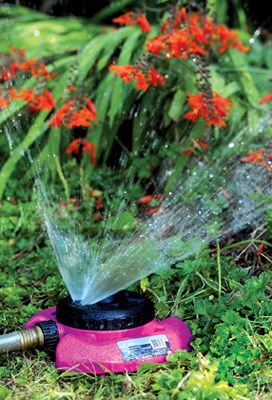EACH year at this time the summer drought hits its stride and parches our gardens.
Fortunately there are several philosophies that promote water conservation and simultaneously promote plant health that everyone can practice. It is important to promote the word "philosophy" and not "product." Most sound horticultural philosophies take advantage of nature's rhythms to provide crop growing benefits. Soil protection is one such horticultural philosophy that facilitates the natural growth of soil life which is capable of improving and building soil structure and fertility. There is a direct correlation between soil structure and the amount of water a soil can hold. And thriving populations of soil bacteria and fungi help plants access far more water than plant roots alone. Soil protection practices must be in use all year to provide peak season benefits. It's a permaculturist's view for sure, one that is uncommon in the garden or landscape maintenance industry where soil protection is often disregarded in favour of cultivation, weeding the same weeds endlessly, herbicide spraying or the installation of useless landscape cloth.
Close cropping is another soil protection technique that grows plants on a tighterthan-normal spacing to allow various plants to grow together. The resulting effect is a gorgeous rolling mosaic of foliage and flower beauty that covers the garden and soil. The benefit beyond beauty is the conservation of soil moisture by lessening evapotranspiration from the soil. Close cropping is not the same as overplanting. Overplanting is the unplanned ugly cousin to close cropping. Real close cropping anticipates and integrates plant growth rates and plant habits to provide foliage cover of the soil. For people who do not like their plants touching, this idea is not for you.
Mulching is another soil protection technique that also conserves water. If you haven't mulched the garden recently, there's no better time than during the annual summer drought. Summer mulching will provide immediate water conservation benefits. Any summer installed mulch should be thoroughly watered and soaked to help future rainfall penetrate the mulch.
Always mulch up close to the base of plants and apply the mulch uniformly. Most commercial mulches like bark or composted bark can be safely applied to ornamental trees, shrubs and perennials at three-to four-inch thickness. Wood chips from arboriculture cutting operations make the best mulch but supply is variable and limited. And no one has started a commercial wood chip mulch business yet. If you practise the philosophy of soil protection and want to use natural rhythms, then an example would be to mulch with fall's leaves to provide drought protection during summer.
Even with soil protection practices in use, watering is usually needed in most gardens at some point during summer's drought which has been unusually long this year. Good watering practices are not complicated but they do require disciplined application. The simple techniques like timing, days of the week and proper sprinkler type for the garden are generally known. But volume control still remains elusive for many residential and commercial landscapes. I visited apartment complexes on the UBC campus this year that had sprinklers running during April's rains which resulted in flooded gardens, drowned plants and compacted soil. Then there's the common but ineffective practice of sprinkler systems running 15 minutes each cycle applied three or four times a week. Best watering practices apply water when the air is going into a cooling phase i.e. during the evening, while applying sufficient water volume to penetrate to a reasonable root depth. The deeper the water penetrates into the soil, the more particles of soil there are to absorb water and hence more water for plants. Regardless of the watering system in use, proper calibration should be done to control the volume to suit the soil and plant types. Calibration is as simple as running the sprinkler(s) once for a specified time period. Afterward, dig test holes throughout the watered area and see how deep the water has penetrated the soil. Make time adjustments according to the results of the test holes and you'll know how much water you are applying.
It is likely that widespread water metering will eventually be in use throughout British Columbia. Many municipalities have been installing water metres in new construction for several years now but not billing the metered quantities, at least not yet. Water conservation should be top of mind for all members of a civil society. Our region currently has a good water supply but that will not always be the case in the future because population growth is a water hungry beast. It is important to remember that conservation is in the public's interest and cheaper than building expensive new infrastructure. So water carefully and accurately it will benefit your plants and the rest of us.
Todd Major is a journeyman horticulturist, garden designer and builder, teacher, skills trainer and organic advocate. For advice, contact him at [email protected].



